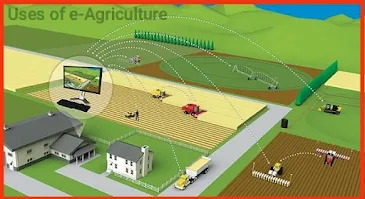E-agriculture meaning and uses of e-agriculture
E-agriculture
In today's rapidly evolving agricultural landscape, the integration of digital technologies is revolutionizing the way farming is practiced worldwide. E-agriculture, or electronic agriculture, represents a paradigm shift in agricultural production, management, and marketing through the use of digital tools, data analytics, and communication platforms. This transformative approach holds the promise of enhancing agricultural productivity, sustainability, and resilience while improving the livelihoods of farmers and strengthening food security. From precision farming and remote monitoring to market access and financial services, e-agriculture offers a comprehensive suite of solutions to address the complex challenges facing the agricultural sector. By harnessing the power of digital innovation, stakeholders across the agricultural value chain can unlock new opportunities for growth, efficiency, and inclusive development.
E-agriculture, or electronic agriculture, is the use of digital technologies, information, and communication tools to enhance agricultural productivity, sustainability, and efficiency. Here's a step-by-step explanation:
Digital Data Collection: This step involves the use of various digital tools to gather comprehensive data on different aspects of agriculture. Sensors embedded in the soil collect information on moisture levels, temperature, and nutrient content. Drones equipped with cameras capture aerial imagery for crop monitoring and mapping. Mobile apps allow farmers to input data on crop growth stages, pest infestations, and disease outbreaks. This data collection process is continuous throughout the farming cycle, providing a wealth of information for analysis.
Data Analysis: The collected data undergoes sophisticated analysis using advanced software programs or artificial intelligence (AI) algorithms. These tools sift through large datasets to identify patterns, correlations, and anomalies. For example, AI algorithms can analyze satellite imagery to detect early signs of crop diseases or nutrient deficiencies. Data analysis also includes predictive modeling to forecast crop yields, optimize resource allocation, and mitigate risks.
Precision Farming: Armed with insights from data analysis, farmers implement precision farming practices. This involves the precise application of inputs such as water, fertilizers, and pesticides based on site-specific conditions. For instance, variable rate technology adjusts the application rates of inputs according to soil fertility maps generated from data analysis. GPS-guided machinery ensures accurate planting, spraying, and harvesting, minimizing waste and maximizing productivity.
Remote Monitoring: IoT devices and remote sensing technologies enable farmers to monitor their fields and livestock from afar. Soil moisture sensors send real-time data to farmers' smartphones, allowing them to adjust irrigation schedules as needed. Livestock wearables track animal health metrics such as heart rate and body temperature, alerting farmers to potential illnesses. Remote monitoring provides timely insights into field conditions and animal behavior, empowering farmers to make proactive decisions.
Market Access: E-agriculture platforms connect farmers directly to markets, bypassing intermediaries and improving price transparency. Online marketplaces enable farmers to list their produce and negotiate prices with buyers. Market information services provide timely updates on commodity prices, demand trends, and export opportunities. This facilitates better decision-making regarding crop selection, timing of harvest, and marketing strategies, ultimately enhancing farmers' profitability and market competitiveness.
Financial Services: E-agriculture initiatives offer financial services tailored to the needs of farmers. Mobile banking apps allow farmers to access savings accounts, transfer funds, and pay bills conveniently from their smartphones. Microfinance institutions provide small loans to farmers for purchasing seeds, fertilizers, and equipment. Insurance products offer protection against crop failures, livestock losses, and natural disasters. Access to financial services helps farmers manage cash flow, invest in productivity-enhancing technologies, and cope with unforeseen risks.
Capacity Building: E-agriculture programs prioritize capacity building through training, extension services, and knowledge sharing. Farmer training workshops teach digital literacy skills, including how to use smartphones, tablets, and agricultural apps effectively. Extension agents provide on-site demonstrations of new technologies and best practices, facilitating technology adoption and behavior change. Online learning platforms offer courses on topics such as sustainable agriculture, climate-smart practices, and digital marketing. Capacity building empowers farmers with the knowledge and skills to leverage digital technologies for improved decision-making and productivity.
Policy Support: Governments and international organizations play a critical role in promoting e-agriculture through supportive policies and investments. Policy frameworks encourage innovation, entrepreneurship, and private sector involvement in the development and deployment of digital agriculture solutions. Funding mechanisms provide grants, subsidies, and tax incentives to incentivize adoption of e-agriculture technologies among smallholder farmers. Infrastructure development initiatives focus on expanding access to reliable internet connectivity, electricity, and mobile network coverage in rural areas. Policy support creates an enabling environment for e-agriculture to thrive, driving sustainable development and inclusive growth in the agricultural sector.
By integrating these steps into their farming practices, agricultural stakeholders can harness the transformative power of e-agriculture to address key challenges facing the sector and unlock new opportunities for growth and prosperity.
Conclusion: In conclusion, e-agriculture stands poised to revolutionize the agricultural sector, offering a pathway to sustainable and inclusive agricultural development in the digital age. By leveraging digital technologies, data-driven insights, and collaborative platforms, farmers can optimize resource use, mitigate risks, and access markets more effectively. Governments, international organizations, and the private sector play pivotal roles in fostering an enabling environment for e-agriculture through supportive policies, investments, and capacity-building initiatives. As we embrace the opportunities presented by e-agriculture, we must also address the challenges of digital divide, data privacy, and cybersecurity to ensure that the benefits of digital transformation are accessible to all farmers, particularly smallholders in developing countries. With concerted efforts and collective action, e-agriculture has the potential to drive sustainable agricultural growth, alleviate poverty, and build resilient food systems for generations to come.
Friends, how did you like this article, you will definitely tell in the comment section and thank you for visiting our website continuously to get such articles.
Join my Teligram channel - Click here
Join my whatsapp group -Click here













Post a Comment